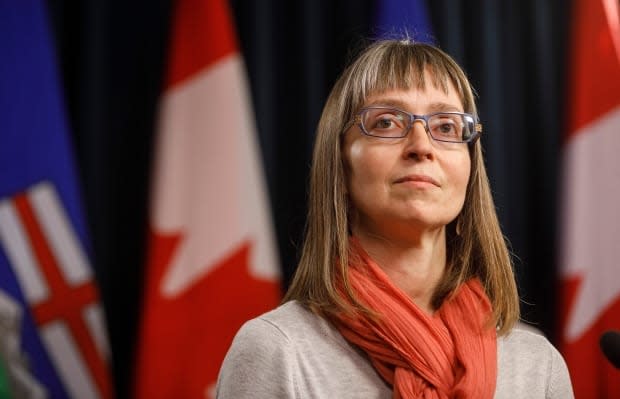Alberta once again shatters COVID-19 record with 1,854 new cases

Alberta once again shattered records on Thursday, with 1,854 new cases and a positive-test rate of 9.5 per cent.
The province has 17,743 active cases, with 511 people being treated in hospital for the illness, including 97 in ICU beds.
Another 14 deaths were reported on Thursday.
"I am very concerned about these numbers," Dr. Deena Hinshaw, the province's chief medical officer of health, said Thursday at a news conference.
"No one should be watching these numbers to determine whether or not they need to change their behaviour. Behaviour needs to change, and that's already a mandate. And what we need to do as we're watching these numbers is determine whether or not there should be further changes."
The regional breakdown of active cases on was:
Edmonton zone: 8,331
Calgary zone: 6,445
Central zone: 1,251
North zone: 991
South zone: 633
Unknown: 92
With case numbers rising in all parts of the province, Hinshaw addressed a portion of her news conference to people who live outside the two big cities.
"While infection rates in Edmonton and Calgary make up the majority of cases in the province, we are seeing increased spread in many rural communities," she said. "COVID-19 is not a Calgary problem or an Edmonton problem. This is a provincial problem within the context of a global problem.
'COVID-19 doesn't care where you live'
Among the 15 geographic areas with the highest active case rates in Alberta, one-third of them are outside Calgary and Edmonton.
"We are also seeing growing outbreaks in the Central, North and South zones," she said. "I know that many rural areas did not see widespread transmission in the spring or summer, and so it's natural that some people living in those areas may feel safe from COVID, due to their smaller populations or distance from large urban centres.
"They may wonder why they should wear a mask or not host a party in their home. Unfortunately, our overall active case rates prove that COVID-19 doesn't care where you live or what your postal code is. It only takes one case entering a community to cause significant spread."
WATCH | Dr. Hinshaw says COVID isn't just a risk for those who live in cities
It's important that everyone follow public health guidelines wherever they live, she said.
"If people in a community aren't consistently observing physical distancing, wearing masks when appropriate or staying home when they feel unwell, it doesn't take long to infect a large percentage of the population.
"Coping with this virus is a challenge for everyone, but being further away from health care, especially from advanced services like ICUs, can also make the experience even more daunting for those living in rural areas. That's why it's important for all Albertans, rural and urban, take COVID-19 seriously and do everything possible to limit the spread."
2nd wave hitting far harder than 1st
The second wave of the pandemic has hit Alberta far harder than the first.
The province reported its first case of the respiratory illness on March 5. It took until June 28, 116 days, for the total number of cases to reach 8,050. That included 7,255 people who had recovered, 641 active cases and 154 deaths.
Alberta reported 8,187 new cases over the past five days alone.
As noted above, the past six days have been grim.
Alberta reported 1,731 new cases on Saturday, 1,608 on Sunday, 1,733 on Monday, 1,307 on Tuesday and 1,685 on Wednesday, and 1,854 on Thursday.
The total number of cases as of Thursday was 63,023, which includes 17,743 active cases, 44,705 people who have recovered, and 575 deaths.
Kenney Q&A
Premier Jason Kenney hosted a live Q&A on Facebook Thursday night that lasted about 90 minutes. When asked about the potential for further restrictions, the premier said the province is currently waiting to see what effect the most recent measures have, before announcing any new measures.
However, Kenney did hint that any possible new restrictions would be linked to the "hot zones" of the province —Edmonton and Calgary.
"If we don't start to see a stabilization or a reduction in the growth, then as I announced last week, we'll have to move forward with additional restrictions," he said. "I suspect that if we do that, those restrictions will be likely geographically focused. In a worst case scenario, we may have to suspend more businesses again."

